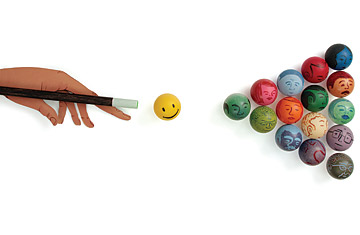
(2 of 2)
In their most recent paper, published in the British Medical Journal, Christakis and Fowler explored the emotional state of nearly 5,000 people and the more than 50,000 social ties they shared. At three points during the long study, all the participants answered a standard questionnaire to determine their happiness level, so that the scientists could track changes in emotional state. That led to their intriguing finding of just how contagious happiness can be: if a subject's friend was happy, that subject was 15% more likely to be happy too; if that friend's friend was happy, the original subject was 10% more likely to be so. Even if the subject's friend's friend's friend--entirely unknown to the subject--was happy, the subject still got a 5.6% boost. The happiness chain also worked in the other direction, radiating from the subject out to her friends. (See the Top 10 late night gags.)
The happiness dividend is more powerful if two people not only know each other but also are equally fond of each other. Happiness is more infectious in mutual relationships (in which both people name the other as a friend) than in unreciprocated ones (in which only one is named).
And it's not just in sterile study settings that the contagion of happiness is spreading. Christakis and Fowler noticed that people who are smiling on their Facebook pages tend to cluster together, forming an online social circle like a delirious flock of cyberbirds. And while some of this joy can certainly be traced to the copycat effect--if your friends post smiling pictures, you might feel like a grouch if you don't too--Christakis and Fowler are analyzing the clusters to see if something more infectious might be at work.
Skeptics raise other concerns, ones that go beyond the copycat effect. Couldn't happy people simply be exposed to similar lifestyles or social factors that explain their shared joy, such as favorable weather, low unemployment rates or a winning baseball team? If that were the case, argue the authors, then happiness would spread more uniformly among all the relationships; instead, it varied depending on whether the friendship was mutual or merely one-sided. As the investigators teased out these factors, they found that environment didn't have nearly the power that relationships did.
The infectiousness of happiness is only the latest in a series of similar phenomena Christakis and Fowler have studied. In 2007 they published a paper showing that obesity travels across webs in a similar way, with individuals having a 57% greater risk of being overweight if they have an obese friend. The same holds true for quitting smoking, with success 30% more common among friends of quitters than among friends of smokers.
In all these cases, there's a predictable topography to how people influence one another, one that can be reduced to a sort of social map. People who are central to their networks--who in effect are the hub through which most of the other relationships or information flows--may have the most influence on others and in turn are the most influenced by them. But just because you start off at the center of your web does not guarantee that you'll stay there. In the 1970s, smokers were more likely to occupy that focal position in their network of friends and family. Look at a similar social map today, and you'll see that the smokers have drifted to the periphery.
The better this kind of mapping becomes, the more value it has. Officials at the Centers for Disease Control and Prevention (CDC) are exploiting the connectedness of youngsters in online social networks, for example, to improve flu-vaccination rates, not just among those under age 18 but among all the people to whom these children have ties. "Because of their social and peer networks, children have a higher likelihood of sharing information with the most people," says Jay Bernhardt of the CDC. By targeting youngsters on these sites with information about the importance of annual flu shots, health officials hope to trigger a literal and figurative viral wave of vaccination among the kids' peers, their peers' peers, and even those peers' parents and grandparents.
"We are always looking for exciting new areas of research that will help people live healthier," says Richard Suzman, director of the division of behavioral and social research at the National Institute on Aging. "Without a doubt, I see this as a very promising area." And with the health community a web like any other, expect that idea to spread further and further.
